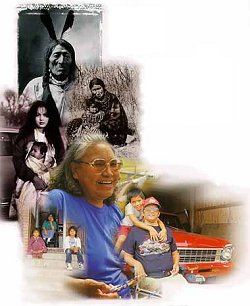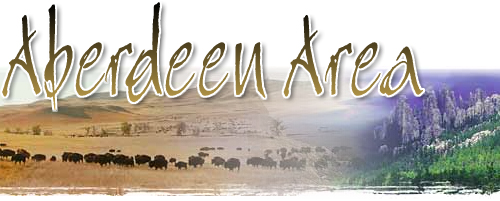| IHS Area Offices |
The People The Native Americans of the Northern Plains are a people who are very proud of their unique traditions and cultural heritage. For over a century, they were subject to assimilation and acculturation. And yet, despite subjugation and oppression, the Native American peoples have succeeded in rejuvenating their cultural legacy, especially as it relates to their traditional values of enhancing family and community.
The Native Americans of the Northern Plains are a people who are very proud of their unique traditions and cultural heritage. For over a century, they were subject to assimilation and acculturation. And yet, despite subjugation and oppression, the Native American peoples have succeeded in rejuvenating their cultural legacy, especially as it relates to their traditional values of enhancing family and community.
In the area of health care, the Tribes take their Constitutionally assigned responsibilities to provide the very best quality of health care for their people very seriously. The Indian Health Service goal of raising the health status of Native Americans on the reservations remains as one of the most challenging undertakings, and the call for Indian Health Service professionals is wholly supported by the Tribes and their people. Professional initiatives in the area of prevention and early detection and diagnosis are noted by the Tribes as being critically needed to assure a healthy work force and healthy families. The practice of traditional Native American medicine rests on the assumption that sickness and disease represent being out of balance with the natural order of living. Hence the approach to healing is holistic and employs certain ceremonies and rites utilizing herbs and roots to assist the sick in returning to wellness and wholeness. The patient's family is also asked to be a part of the healing process because achieving wellness most often requires changing one's lifestyle from a negative to a positive way of living. As was the case historically, the traditional healers, the Medicine Men of today, are highly esteemed in the community, not only in regard to their role and function as healers of the body and mind, but also as community leaders among the people who seek counsel and direction. Both historically and today, the social life of the Native peoples rests simply on the primacy of family. The immediate family consists of husband, wife, and children. This family nucleus is called tiwahe in the Dakota language. The extended family is comprised of husband's and wife's parents, siblings, uncles, and aunts. The extended family is called tiospaye and is often translated as clan. Within the clan, bonds of relationship and acknowledgment of responsibilities for one another are very strong. The inter-related network of the clan is called ospaye and is often translated as Band. And finally, the composite of Bands is called Oaye which translates as Nation. These structures of family and kinship are held together based on overwhelming religious and spiritual convictions which are intimately associated with the land and the sacred sites within each Band's area.
The traditional value of respect for one another is extended to the animals of the land as well, particularly to the buffalo which once served as the main source of wealth and economic self- sufficiency for the Northern Plains Tribes. The buffalo as a provider of food, clothing, medicine, and shelter is also viewed as a necessary part of religious ceremony. The traditional religious leaders, rather than viewing mankind as superior to the animal world, hold that man is but a component of the natural order and consistently have instructed the people about the need to look closely at the natural order of the animals and the environment wherein there is absolute order and harmony. In the early 1900's, the practice of traditional medicine among the Bands fell subject to direct federal intervention. The practice of healing rites and ceremonies of the people were outlawed, and at the same time, western medicine was not provided to alleviate the sickness and disease that had taken over entire tribes. Since 1978 however, traditional medicine and the healing ways of the people have surfaced and are flourishing among Native American traditional practitioners today. Today Native Americans live and function in a bi-cultural society. Native residents are overwhelmingly youthful and represent one of the youngest rural populations. In every native community, the value of family is emphasized by dances called "pow-wows" which are held as a means of celebration and entertainment and also for purposes of family reunions, naming ceremonies, honor songs, and commemoration of relatives who have passed away. The Native songs of the pow-wow incorporate the drum and dancing and represent a highly refined aesthetic experience involving people of all ages from toddlers to the elderly. On the reservations, the Tribal governments have had to be innovative and aggressive in private sector development. The results of such initiatives are apparent in terms of job creation in new industries and development of new infrastructures, as well as the recent establishment of gaming enterprises, all of which have yielded both jobs and income for the Tribes. Today, the various Native American tongues can be heard throughout their communities and are taught in Tribal schools. The traditional Native elders assert that the legends, values, and customs of their people must be spoken in the Native language, as it is the language of the heart. The elders say that it is the heart which forgives the errors and mistakes of the past and yet provides motivation and hope for the future of the people. It is this philosophy which is being embraced by a whole new youthful generation committed to the enhancement of their Native American identity. Family relationships continue to influence social interaction among Native Americans and serve as the basis for involvement in every sphere of life today within the Native communities. It is a combination of their unique heritage, their traditional value system and their strong cultural and family bonds that hold them together and make them a strong people.  |


 Native families, in the fullness and richness of religious ceremonies, have gained certain spiritual experiences, particularly with respect to the traditional four ages each person experiences: infancy/childhood, adolescence, adulthood, and old age. For each stage of life, the family sponsors and enacts certain ceremonies which are connected to the land and sacred sites of their Band.
Native families, in the fullness and richness of religious ceremonies, have gained certain spiritual experiences, particularly with respect to the traditional four ages each person experiences: infancy/childhood, adolescence, adulthood, and old age. For each stage of life, the family sponsors and enacts certain ceremonies which are connected to the land and sacred sites of their Band.